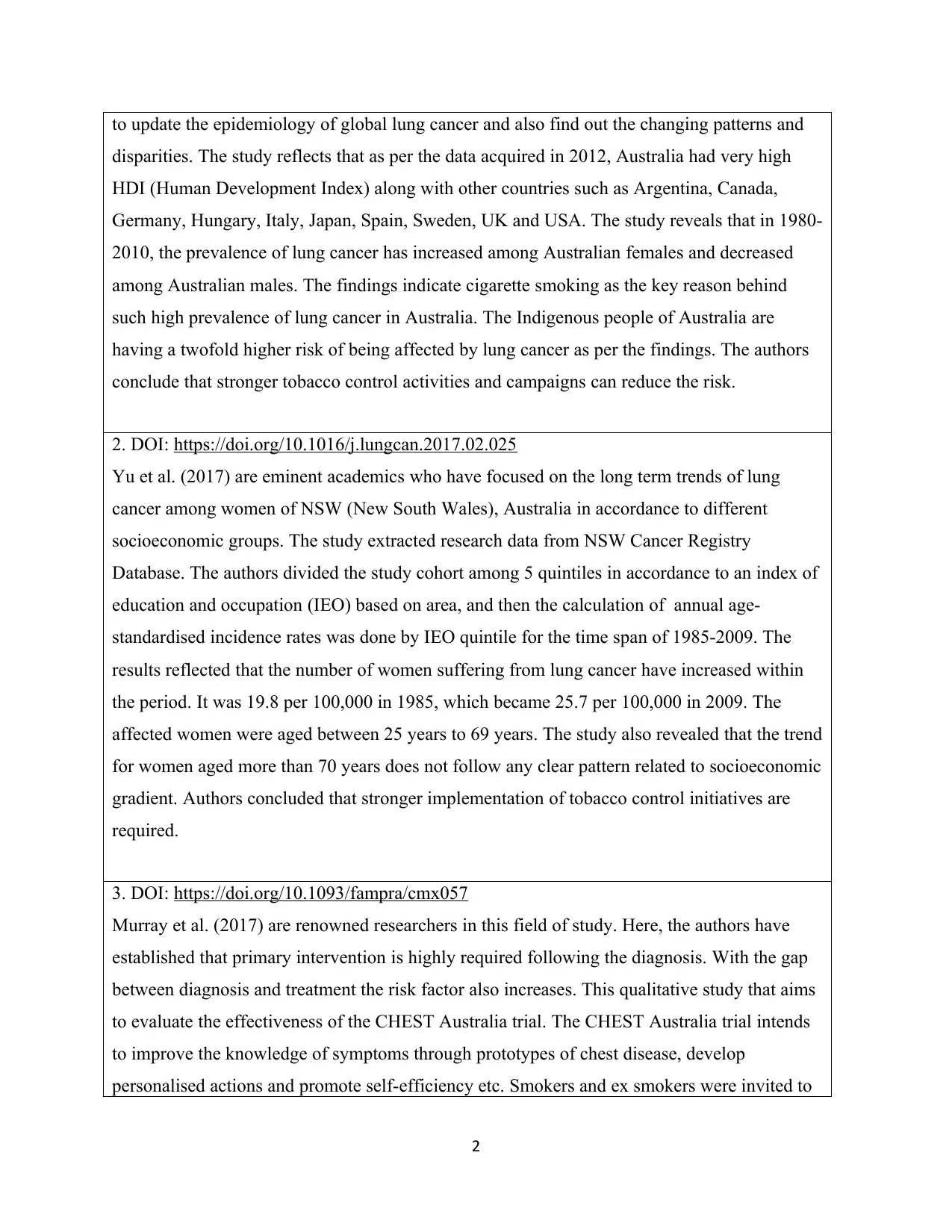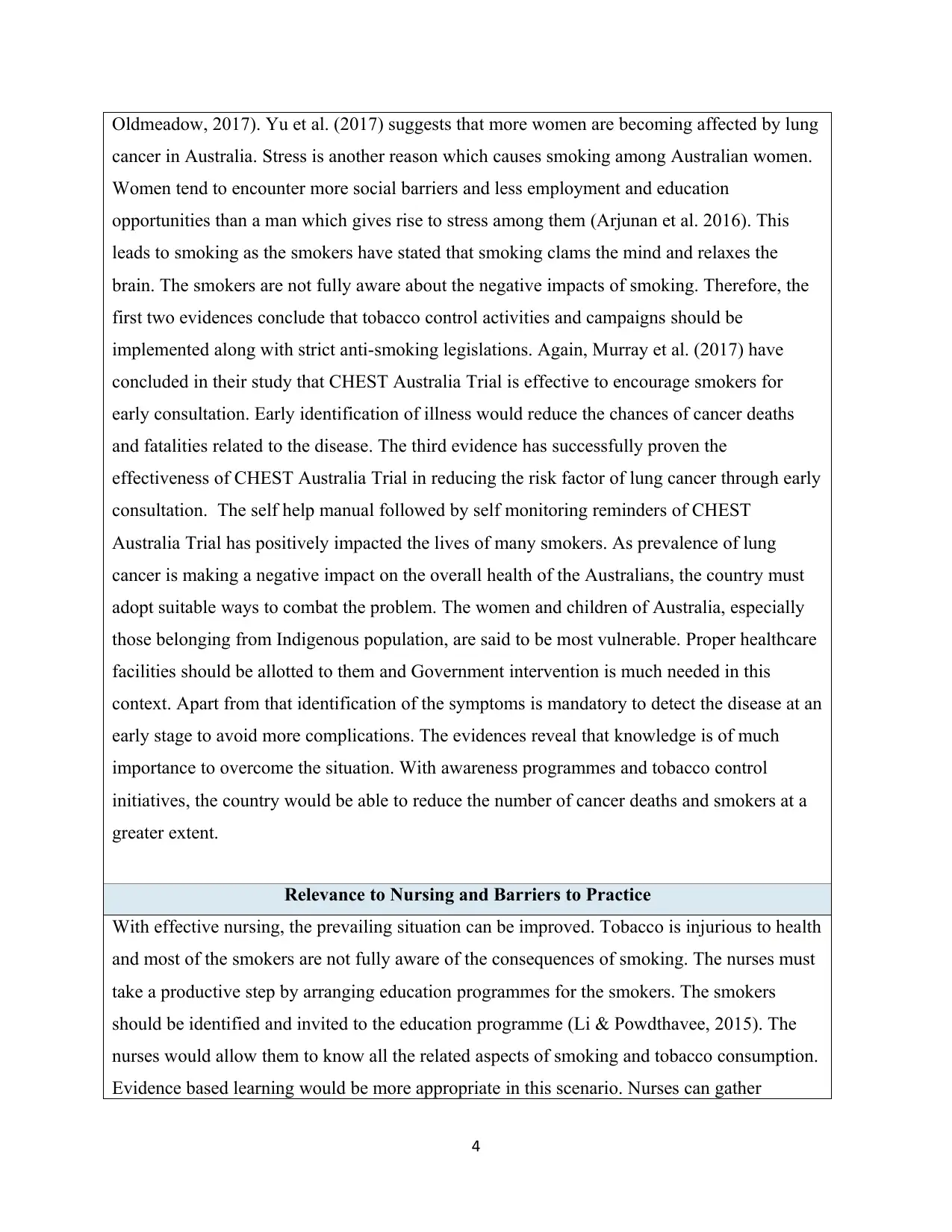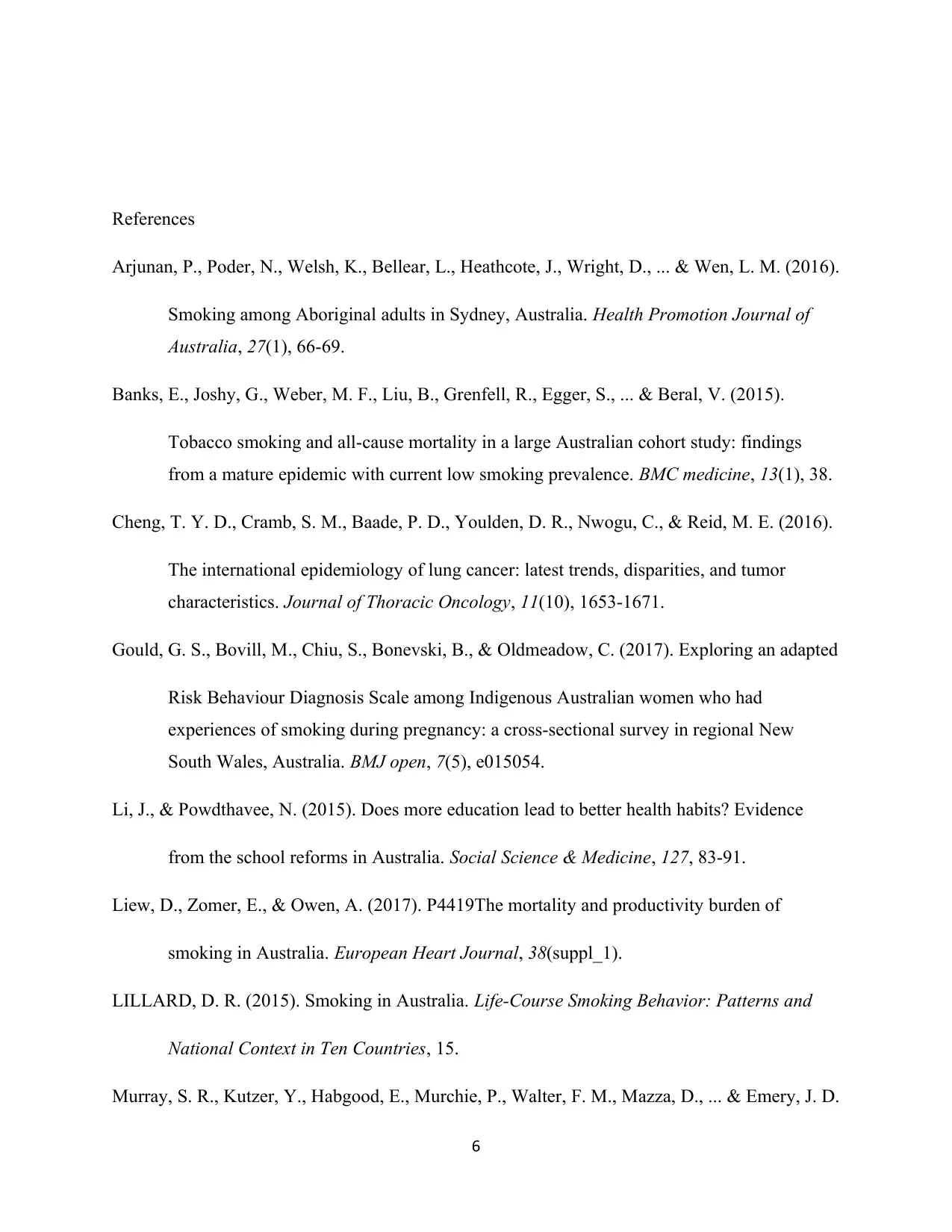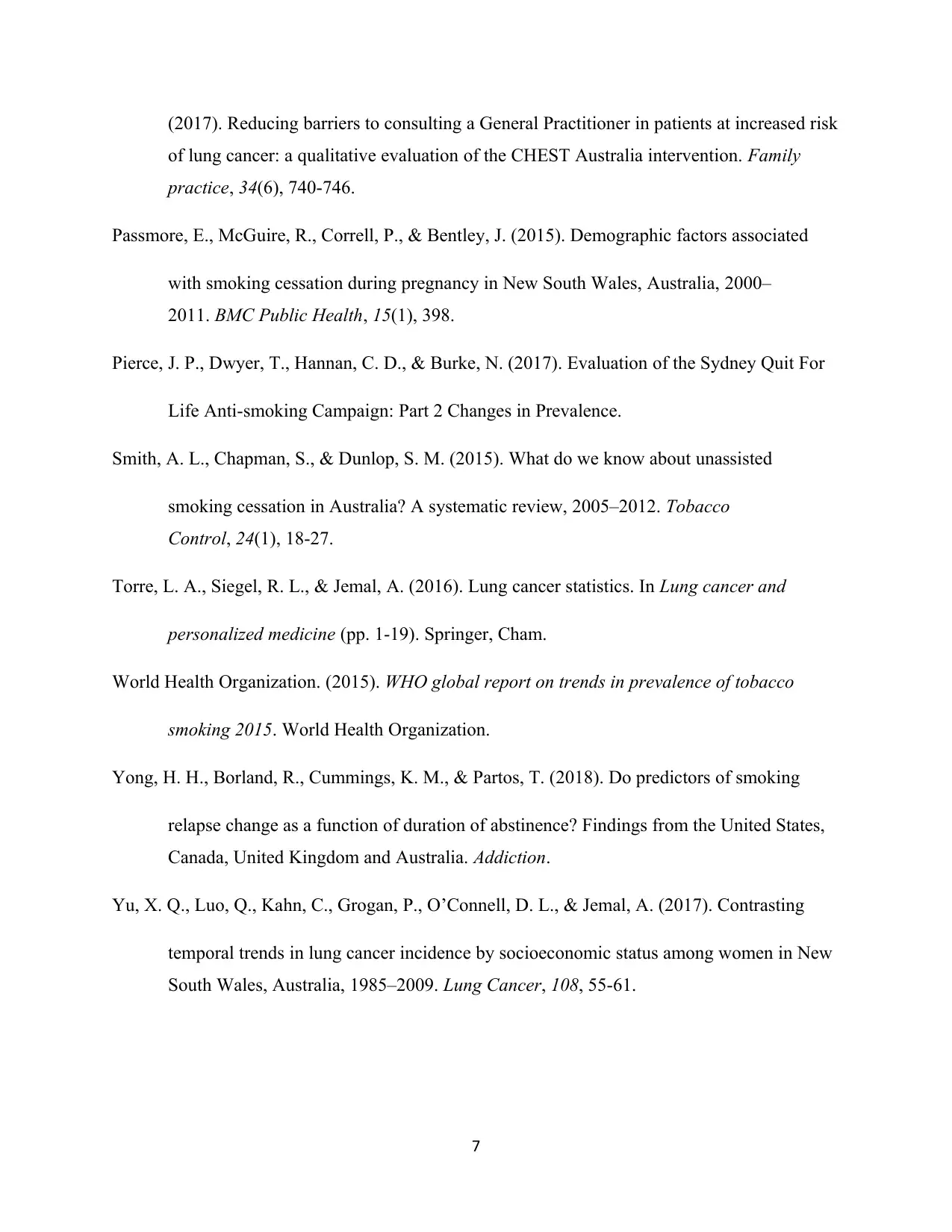Critique of Lung Cancer Literature in Australia (NUR342, 2018)
VerifiedAdded on 2023/06/03
|8
|2602
|185
Essay
AI Summary
This essay critically analyzes existing literature on lung cancer, focusing on the Australian context. It examines the prevalence of the disease, particularly the impact of smoking and tobacco consumption on the population, with specific attention to women and Indigenous communities. The essay explores the findings of key research studies, including those focusing on tobacco control activities, the trends of lung cancer, and the effectiveness of interventions like the CHEST Australia trial. It highlights the relevance of these findings to nursing practice, emphasizing the role of nurses in educating patients, identifying early symptoms, and providing effective healthcare services. The essay also discusses the barriers to practice and the need for improved healthcare policies and awareness programs to combat the rising incidence of lung cancer in Australia. The essay is a critique of the literature and its impact in the healthcare sector.

Assessment 3 Essay: A critique of the literature
Assessment 3
Introduction
Lung cancer is a common disease among Australian population. Most of the deaths caused by
cancer in Australia are caused from Lung cancer. Approximately 1 in every 5 cancer deaths are
caused by Lung cancer (Torre, Siegel & Jemal, 2016). Therefore, it is a serious concern of the
country. I live in Australia and I have seen my 26 years old neighbour dying of lung cancer.
She left a 3 years old son behind and her family is devastated. This way, lung cancer takes
lives of a large number of people in Australia. Some of those families lose their sole bread
earning member to this deadly disease. I want to gather effective knowledge regarding the
same to spread awareness so that the number of deaths can be reduced to a greater extent.
Best Evidence
Best Practice Level of
Evidence
Study Design In-text Citation in CDU
APA 6th Format
Tobacco control activities
and awareness campaign
5 Qualitative
research
(Cheng et al. 2016)
Trends of lung cancer
among women of NSW,
Australia
4 Cohort study (Yu et al. 2017)
CHEST Australia Trial 7 Qualitative
research
(Murray et al. 2017)
Annotated Bibliography
1. DOI: https://doi.org/10.1016/j.jtho.2016.05.021
Cheng et al. (2016) are well published academics who have worked on different aspects of
Lung cancer including its latest trends, disparities and characteristics of tumour. Their aim was
1
Assessment 3
Introduction
Lung cancer is a common disease among Australian population. Most of the deaths caused by
cancer in Australia are caused from Lung cancer. Approximately 1 in every 5 cancer deaths are
caused by Lung cancer (Torre, Siegel & Jemal, 2016). Therefore, it is a serious concern of the
country. I live in Australia and I have seen my 26 years old neighbour dying of lung cancer.
She left a 3 years old son behind and her family is devastated. This way, lung cancer takes
lives of a large number of people in Australia. Some of those families lose their sole bread
earning member to this deadly disease. I want to gather effective knowledge regarding the
same to spread awareness so that the number of deaths can be reduced to a greater extent.
Best Evidence
Best Practice Level of
Evidence
Study Design In-text Citation in CDU
APA 6th Format
Tobacco control activities
and awareness campaign
5 Qualitative
research
(Cheng et al. 2016)
Trends of lung cancer
among women of NSW,
Australia
4 Cohort study (Yu et al. 2017)
CHEST Australia Trial 7 Qualitative
research
(Murray et al. 2017)
Annotated Bibliography
1. DOI: https://doi.org/10.1016/j.jtho.2016.05.021
Cheng et al. (2016) are well published academics who have worked on different aspects of
Lung cancer including its latest trends, disparities and characteristics of tumour. Their aim was
1
Paraphrase This Document
Need a fresh take? Get an instant paraphrase of this document with our AI Paraphraser

to update the epidemiology of global lung cancer and also find out the changing patterns and
disparities. The study reflects that as per the data acquired in 2012, Australia had very high
HDI (Human Development Index) along with other countries such as Argentina, Canada,
Germany, Hungary, Italy, Japan, Spain, Sweden, UK and USA. The study reveals that in 1980-
2010, the prevalence of lung cancer has increased among Australian females and decreased
among Australian males. The findings indicate cigarette smoking as the key reason behind
such high prevalence of lung cancer in Australia. The Indigenous people of Australia are
having a twofold higher risk of being affected by lung cancer as per the findings. The authors
conclude that stronger tobacco control activities and campaigns can reduce the risk.
2. DOI: https://doi.org/10.1016/j.lungcan.2017.02.025
Yu et al. (2017) are eminent academics who have focused on the long term trends of lung
cancer among women of NSW (New South Wales), Australia in accordance to different
socioeconomic groups. The study extracted research data from NSW Cancer Registry
Database. The authors divided the study cohort among 5 quintiles in accordance to an index of
education and occupation (IEO) based on area, and then the calculation of annual age-
standardised incidence rates was done by IEO quintile for the time span of 1985-2009. The
results reflected that the number of women suffering from lung cancer have increased within
the period. It was 19.8 per 100,000 in 1985, which became 25.7 per 100,000 in 2009. The
affected women were aged between 25 years to 69 years. The study also revealed that the trend
for women aged more than 70 years does not follow any clear pattern related to socioeconomic
gradient. Authors concluded that stronger implementation of tobacco control initiatives are
required.
3. DOI: https://doi.org/10.1093/fampra/cmx057
Murray et al. (2017) are renowned researchers in this field of study. Here, the authors have
established that primary intervention is highly required following the diagnosis. With the gap
between diagnosis and treatment the risk factor also increases. This qualitative study that aims
to evaluate the effectiveness of the CHEST Australia trial. The CHEST Australia trial intends
to improve the knowledge of symptoms through prototypes of chest disease, develop
personalised actions and promote self-efficiency etc. Smokers and ex smokers were invited to
2
disparities. The study reflects that as per the data acquired in 2012, Australia had very high
HDI (Human Development Index) along with other countries such as Argentina, Canada,
Germany, Hungary, Italy, Japan, Spain, Sweden, UK and USA. The study reveals that in 1980-
2010, the prevalence of lung cancer has increased among Australian females and decreased
among Australian males. The findings indicate cigarette smoking as the key reason behind
such high prevalence of lung cancer in Australia. The Indigenous people of Australia are
having a twofold higher risk of being affected by lung cancer as per the findings. The authors
conclude that stronger tobacco control activities and campaigns can reduce the risk.
2. DOI: https://doi.org/10.1016/j.lungcan.2017.02.025
Yu et al. (2017) are eminent academics who have focused on the long term trends of lung
cancer among women of NSW (New South Wales), Australia in accordance to different
socioeconomic groups. The study extracted research data from NSW Cancer Registry
Database. The authors divided the study cohort among 5 quintiles in accordance to an index of
education and occupation (IEO) based on area, and then the calculation of annual age-
standardised incidence rates was done by IEO quintile for the time span of 1985-2009. The
results reflected that the number of women suffering from lung cancer have increased within
the period. It was 19.8 per 100,000 in 1985, which became 25.7 per 100,000 in 2009. The
affected women were aged between 25 years to 69 years. The study also revealed that the trend
for women aged more than 70 years does not follow any clear pattern related to socioeconomic
gradient. Authors concluded that stronger implementation of tobacco control initiatives are
required.
3. DOI: https://doi.org/10.1093/fampra/cmx057
Murray et al. (2017) are renowned researchers in this field of study. Here, the authors have
established that primary intervention is highly required following the diagnosis. With the gap
between diagnosis and treatment the risk factor also increases. This qualitative study that aims
to evaluate the effectiveness of the CHEST Australia trial. The CHEST Australia trial intends
to improve the knowledge of symptoms through prototypes of chest disease, develop
personalised actions and promote self-efficiency etc. Smokers and ex smokers were invited to
2

be part of this study and data was extracted through face-to-face interviews. This way the
researchers were able to observe nonverbal cues and body language of the participator while
they shared their experiences. Sampling was on the basis of age, location, gender and smoking
status and the type was purposive sampling. 20 people participated in the survey. The result
obtained reflected that the intervention provided effects which were theoretically underpinned.
Justifying the Evidence
Lung cancer is a much talked about issue globally. The studies reflect that Australia possess a
high rank among the countries having most people being affected of lung cancer. In Australia,
lung cancer is considered as one of the most severe diseases. A large number of Australians,
adult males and females, are diagnosed with lung cancer every year (Banks et al. 2015). There
are a number of reasons which causes lung cancer. But in Australia, smoking and consumption
of tobacco is considered as one of the major causes of lung cancer (LILLARD, 2015). In
Australia, the number of smokers increases rapidly. People suffering from lung cancer are
mostly associated with smoking or tobacco. Possession of tobacco or cigarettes is very
common among Australian men and women. The evidence provided by Cheng et al. (2016)
reflects that the number of Australian women consuming tobacco have increased rapidly in
past years. Despite of different anti-smoking laws presented by the Australian Government, the
situation is not being improved. Moreover, teenage smoking has emerged as a new issue in
Australia (World Health Organization. 2015). With women smoking cigarettes, the overall
graph of women’s health of the country is going downwards (Liew, Zomer & Owen, 2017).
This is adversely making a negative impact on the children’s health as well. Rising number of
infant deaths has come across as an inevitable outcome of rapid smoking by childbearing
mothers (Passmore, McGuire, Correll & Bentley, 2015). Thus, the health of both the child and
the mother are at stake. As it is known that an Australian population comprises of Indigenous
people, the smoking rates among them are comparatively higher (Smith, Chapman & Dunlop,
2015). Due to their socio-economical status, lack of employment opportunities, discrimination,
the males and females of Aboriginal and Torres Strait Islander people are having relatively
higher smoking rates. This is why the women of Indigenous communities tend to encounter
lung cancer more than a non-Indigenous Australian (Gould, Bovill, Chiu, Bonevski &
3
researchers were able to observe nonverbal cues and body language of the participator while
they shared their experiences. Sampling was on the basis of age, location, gender and smoking
status and the type was purposive sampling. 20 people participated in the survey. The result
obtained reflected that the intervention provided effects which were theoretically underpinned.
Justifying the Evidence
Lung cancer is a much talked about issue globally. The studies reflect that Australia possess a
high rank among the countries having most people being affected of lung cancer. In Australia,
lung cancer is considered as one of the most severe diseases. A large number of Australians,
adult males and females, are diagnosed with lung cancer every year (Banks et al. 2015). There
are a number of reasons which causes lung cancer. But in Australia, smoking and consumption
of tobacco is considered as one of the major causes of lung cancer (LILLARD, 2015). In
Australia, the number of smokers increases rapidly. People suffering from lung cancer are
mostly associated with smoking or tobacco. Possession of tobacco or cigarettes is very
common among Australian men and women. The evidence provided by Cheng et al. (2016)
reflects that the number of Australian women consuming tobacco have increased rapidly in
past years. Despite of different anti-smoking laws presented by the Australian Government, the
situation is not being improved. Moreover, teenage smoking has emerged as a new issue in
Australia (World Health Organization. 2015). With women smoking cigarettes, the overall
graph of women’s health of the country is going downwards (Liew, Zomer & Owen, 2017).
This is adversely making a negative impact on the children’s health as well. Rising number of
infant deaths has come across as an inevitable outcome of rapid smoking by childbearing
mothers (Passmore, McGuire, Correll & Bentley, 2015). Thus, the health of both the child and
the mother are at stake. As it is known that an Australian population comprises of Indigenous
people, the smoking rates among them are comparatively higher (Smith, Chapman & Dunlop,
2015). Due to their socio-economical status, lack of employment opportunities, discrimination,
the males and females of Aboriginal and Torres Strait Islander people are having relatively
higher smoking rates. This is why the women of Indigenous communities tend to encounter
lung cancer more than a non-Indigenous Australian (Gould, Bovill, Chiu, Bonevski &
3
⊘ This is a preview!⊘
Do you want full access?
Subscribe today to unlock all pages.

Trusted by 1+ million students worldwide

Oldmeadow, 2017). Yu et al. (2017) suggests that more women are becoming affected by lung
cancer in Australia. Stress is another reason which causes smoking among Australian women.
Women tend to encounter more social barriers and less employment and education
opportunities than a man which gives rise to stress among them (Arjunan et al. 2016). This
leads to smoking as the smokers have stated that smoking clams the mind and relaxes the
brain. The smokers are not fully aware about the negative impacts of smoking. Therefore, the
first two evidences conclude that tobacco control activities and campaigns should be
implemented along with strict anti-smoking legislations. Again, Murray et al. (2017) have
concluded in their study that CHEST Australia Trial is effective to encourage smokers for
early consultation. Early identification of illness would reduce the chances of cancer deaths
and fatalities related to the disease. The third evidence has successfully proven the
effectiveness of CHEST Australia Trial in reducing the risk factor of lung cancer through early
consultation. The self help manual followed by self monitoring reminders of CHEST
Australia Trial has positively impacted the lives of many smokers. As prevalence of lung
cancer is making a negative impact on the overall health of the Australians, the country must
adopt suitable ways to combat the problem. The women and children of Australia, especially
those belonging from Indigenous population, are said to be most vulnerable. Proper healthcare
facilities should be allotted to them and Government intervention is much needed in this
context. Apart from that identification of the symptoms is mandatory to detect the disease at an
early stage to avoid more complications. The evidences reveal that knowledge is of much
importance to overcome the situation. With awareness programmes and tobacco control
initiatives, the country would be able to reduce the number of cancer deaths and smokers at a
greater extent.
Relevance to Nursing and Barriers to Practice
With effective nursing, the prevailing situation can be improved. Tobacco is injurious to health
and most of the smokers are not fully aware of the consequences of smoking. The nurses must
take a productive step by arranging education programmes for the smokers. The smokers
should be identified and invited to the education programme (Li & Powdthavee, 2015). The
nurses would allow them to know all the related aspects of smoking and tobacco consumption.
Evidence based learning would be more appropriate in this scenario. Nurses can gather
4
cancer in Australia. Stress is another reason which causes smoking among Australian women.
Women tend to encounter more social barriers and less employment and education
opportunities than a man which gives rise to stress among them (Arjunan et al. 2016). This
leads to smoking as the smokers have stated that smoking clams the mind and relaxes the
brain. The smokers are not fully aware about the negative impacts of smoking. Therefore, the
first two evidences conclude that tobacco control activities and campaigns should be
implemented along with strict anti-smoking legislations. Again, Murray et al. (2017) have
concluded in their study that CHEST Australia Trial is effective to encourage smokers for
early consultation. Early identification of illness would reduce the chances of cancer deaths
and fatalities related to the disease. The third evidence has successfully proven the
effectiveness of CHEST Australia Trial in reducing the risk factor of lung cancer through early
consultation. The self help manual followed by self monitoring reminders of CHEST
Australia Trial has positively impacted the lives of many smokers. As prevalence of lung
cancer is making a negative impact on the overall health of the Australians, the country must
adopt suitable ways to combat the problem. The women and children of Australia, especially
those belonging from Indigenous population, are said to be most vulnerable. Proper healthcare
facilities should be allotted to them and Government intervention is much needed in this
context. Apart from that identification of the symptoms is mandatory to detect the disease at an
early stage to avoid more complications. The evidences reveal that knowledge is of much
importance to overcome the situation. With awareness programmes and tobacco control
initiatives, the country would be able to reduce the number of cancer deaths and smokers at a
greater extent.
Relevance to Nursing and Barriers to Practice
With effective nursing, the prevailing situation can be improved. Tobacco is injurious to health
and most of the smokers are not fully aware of the consequences of smoking. The nurses must
take a productive step by arranging education programmes for the smokers. The smokers
should be identified and invited to the education programme (Li & Powdthavee, 2015). The
nurses would allow them to know all the related aspects of smoking and tobacco consumption.
Evidence based learning would be more appropriate in this scenario. Nurses can gather
4
Paraphrase This Document
Need a fresh take? Get an instant paraphrase of this document with our AI Paraphraser

adequate evidence related to lung cancer cases in Australia and cancer deaths (Pierce, Dwyer,
Hannan & Burke, 2017). This would strengthen their education programme and allow the
smokers to gain deeper understanding regarding the factors of smoking. Nurses can use their
knowledge to identify early symptoms of lung cancer and initiate treatment on the basis of
that. Screening tools can also be used by nurses to trace affected people from potential
smokers. Nurses are responsible for rendering healthcare services to the people affected from
lung cancer. Being equipped with clinical knowledge about different illnesses, nurses are able
to provide best healthcare services to the patients and accelerate the recovery process. Hence,
it can be said that nurses have the power to educate and treat people and reduce the number of
cancer deaths in the country. Although the researches are not able to analyse the healthcare
policies of the country which is much relevant in this context. With proper healthcare policies
at place, tobacco selling and consumption can be reduced, thereby, reducing the total number
of smokers in the country (Yong, Borland, Cummings & Partos, 2018). However, the
evidences successfully highlight and explore the situation related to prevalence of lung cancer
in Australia. With more awareness programmes and preventive measures, the number of lung
cancer affected people can be reduced to a greater extent.
5
Hannan & Burke, 2017). This would strengthen their education programme and allow the
smokers to gain deeper understanding regarding the factors of smoking. Nurses can use their
knowledge to identify early symptoms of lung cancer and initiate treatment on the basis of
that. Screening tools can also be used by nurses to trace affected people from potential
smokers. Nurses are responsible for rendering healthcare services to the people affected from
lung cancer. Being equipped with clinical knowledge about different illnesses, nurses are able
to provide best healthcare services to the patients and accelerate the recovery process. Hence,
it can be said that nurses have the power to educate and treat people and reduce the number of
cancer deaths in the country. Although the researches are not able to analyse the healthcare
policies of the country which is much relevant in this context. With proper healthcare policies
at place, tobacco selling and consumption can be reduced, thereby, reducing the total number
of smokers in the country (Yong, Borland, Cummings & Partos, 2018). However, the
evidences successfully highlight and explore the situation related to prevalence of lung cancer
in Australia. With more awareness programmes and preventive measures, the number of lung
cancer affected people can be reduced to a greater extent.
5

References
Arjunan, P., Poder, N., Welsh, K., Bellear, L., Heathcote, J., Wright, D., ... & Wen, L. M. (2016).
Smoking among Aboriginal adults in Sydney, Australia. Health Promotion Journal of
Australia, 27(1), 66-69.
Banks, E., Joshy, G., Weber, M. F., Liu, B., Grenfell, R., Egger, S., ... & Beral, V. (2015).
Tobacco smoking and all-cause mortality in a large Australian cohort study: findings
from a mature epidemic with current low smoking prevalence. BMC medicine, 13(1), 38.
Cheng, T. Y. D., Cramb, S. M., Baade, P. D., Youlden, D. R., Nwogu, C., & Reid, M. E. (2016).
The international epidemiology of lung cancer: latest trends, disparities, and tumor
characteristics. Journal of Thoracic Oncology, 11(10), 1653-1671.
Gould, G. S., Bovill, M., Chiu, S., Bonevski, B., & Oldmeadow, C. (2017). Exploring an adapted
Risk Behaviour Diagnosis Scale among Indigenous Australian women who had
experiences of smoking during pregnancy: a cross-sectional survey in regional New
South Wales, Australia. BMJ open, 7(5), e015054.
Li, J., & Powdthavee, N. (2015). Does more education lead to better health habits? Evidence
from the school reforms in Australia. Social Science & Medicine, 127, 83-91.
Liew, D., Zomer, E., & Owen, A. (2017). P4419The mortality and productivity burden of
smoking in Australia. European Heart Journal, 38(suppl_1).
LILLARD, D. R. (2015). Smoking in Australia. Life-Course Smoking Behavior: Patterns and
National Context in Ten Countries, 15.
Murray, S. R., Kutzer, Y., Habgood, E., Murchie, P., Walter, F. M., Mazza, D., ... & Emery, J. D.
6
Arjunan, P., Poder, N., Welsh, K., Bellear, L., Heathcote, J., Wright, D., ... & Wen, L. M. (2016).
Smoking among Aboriginal adults in Sydney, Australia. Health Promotion Journal of
Australia, 27(1), 66-69.
Banks, E., Joshy, G., Weber, M. F., Liu, B., Grenfell, R., Egger, S., ... & Beral, V. (2015).
Tobacco smoking and all-cause mortality in a large Australian cohort study: findings
from a mature epidemic with current low smoking prevalence. BMC medicine, 13(1), 38.
Cheng, T. Y. D., Cramb, S. M., Baade, P. D., Youlden, D. R., Nwogu, C., & Reid, M. E. (2016).
The international epidemiology of lung cancer: latest trends, disparities, and tumor
characteristics. Journal of Thoracic Oncology, 11(10), 1653-1671.
Gould, G. S., Bovill, M., Chiu, S., Bonevski, B., & Oldmeadow, C. (2017). Exploring an adapted
Risk Behaviour Diagnosis Scale among Indigenous Australian women who had
experiences of smoking during pregnancy: a cross-sectional survey in regional New
South Wales, Australia. BMJ open, 7(5), e015054.
Li, J., & Powdthavee, N. (2015). Does more education lead to better health habits? Evidence
from the school reforms in Australia. Social Science & Medicine, 127, 83-91.
Liew, D., Zomer, E., & Owen, A. (2017). P4419The mortality and productivity burden of
smoking in Australia. European Heart Journal, 38(suppl_1).
LILLARD, D. R. (2015). Smoking in Australia. Life-Course Smoking Behavior: Patterns and
National Context in Ten Countries, 15.
Murray, S. R., Kutzer, Y., Habgood, E., Murchie, P., Walter, F. M., Mazza, D., ... & Emery, J. D.
6
⊘ This is a preview!⊘
Do you want full access?
Subscribe today to unlock all pages.

Trusted by 1+ million students worldwide

(2017). Reducing barriers to consulting a General Practitioner in patients at increased risk
of lung cancer: a qualitative evaluation of the CHEST Australia intervention. Family
practice, 34(6), 740-746.
Passmore, E., McGuire, R., Correll, P., & Bentley, J. (2015). Demographic factors associated
with smoking cessation during pregnancy in New South Wales, Australia, 2000–
2011. BMC Public Health, 15(1), 398.
Pierce, J. P., Dwyer, T., Hannan, C. D., & Burke, N. (2017). Evaluation of the Sydney Quit For
Life Anti-smoking Campaign: Part 2 Changes in Prevalence.
Smith, A. L., Chapman, S., & Dunlop, S. M. (2015). What do we know about unassisted
smoking cessation in Australia? A systematic review, 2005–2012. Tobacco
Control, 24(1), 18-27.
Torre, L. A., Siegel, R. L., & Jemal, A. (2016). Lung cancer statistics. In Lung cancer and
personalized medicine (pp. 1-19). Springer, Cham.
World Health Organization. (2015). WHO global report on trends in prevalence of tobacco
smoking 2015. World Health Organization.
Yong, H. H., Borland, R., Cummings, K. M., & Partos, T. (2018). Do predictors of smoking
relapse change as a function of duration of abstinence? Findings from the United States,
Canada, United Kingdom and Australia. Addiction.
Yu, X. Q., Luo, Q., Kahn, C., Grogan, P., O’Connell, D. L., & Jemal, A. (2017). Contrasting
temporal trends in lung cancer incidence by socioeconomic status among women in New
South Wales, Australia, 1985–2009. Lung Cancer, 108, 55-61.
7
of lung cancer: a qualitative evaluation of the CHEST Australia intervention. Family
practice, 34(6), 740-746.
Passmore, E., McGuire, R., Correll, P., & Bentley, J. (2015). Demographic factors associated
with smoking cessation during pregnancy in New South Wales, Australia, 2000–
2011. BMC Public Health, 15(1), 398.
Pierce, J. P., Dwyer, T., Hannan, C. D., & Burke, N. (2017). Evaluation of the Sydney Quit For
Life Anti-smoking Campaign: Part 2 Changes in Prevalence.
Smith, A. L., Chapman, S., & Dunlop, S. M. (2015). What do we know about unassisted
smoking cessation in Australia? A systematic review, 2005–2012. Tobacco
Control, 24(1), 18-27.
Torre, L. A., Siegel, R. L., & Jemal, A. (2016). Lung cancer statistics. In Lung cancer and
personalized medicine (pp. 1-19). Springer, Cham.
World Health Organization. (2015). WHO global report on trends in prevalence of tobacco
smoking 2015. World Health Organization.
Yong, H. H., Borland, R., Cummings, K. M., & Partos, T. (2018). Do predictors of smoking
relapse change as a function of duration of abstinence? Findings from the United States,
Canada, United Kingdom and Australia. Addiction.
Yu, X. Q., Luo, Q., Kahn, C., Grogan, P., O’Connell, D. L., & Jemal, A. (2017). Contrasting
temporal trends in lung cancer incidence by socioeconomic status among women in New
South Wales, Australia, 1985–2009. Lung Cancer, 108, 55-61.
7
Paraphrase This Document
Need a fresh take? Get an instant paraphrase of this document with our AI Paraphraser

8
1 out of 8
Related Documents
Your All-in-One AI-Powered Toolkit for Academic Success.
+13062052269
info@desklib.com
Available 24*7 on WhatsApp / Email
![[object Object]](/_next/static/media/star-bottom.7253800d.svg)
Unlock your academic potential
Copyright © 2020–2025 A2Z Services. All Rights Reserved. Developed and managed by ZUCOL.




